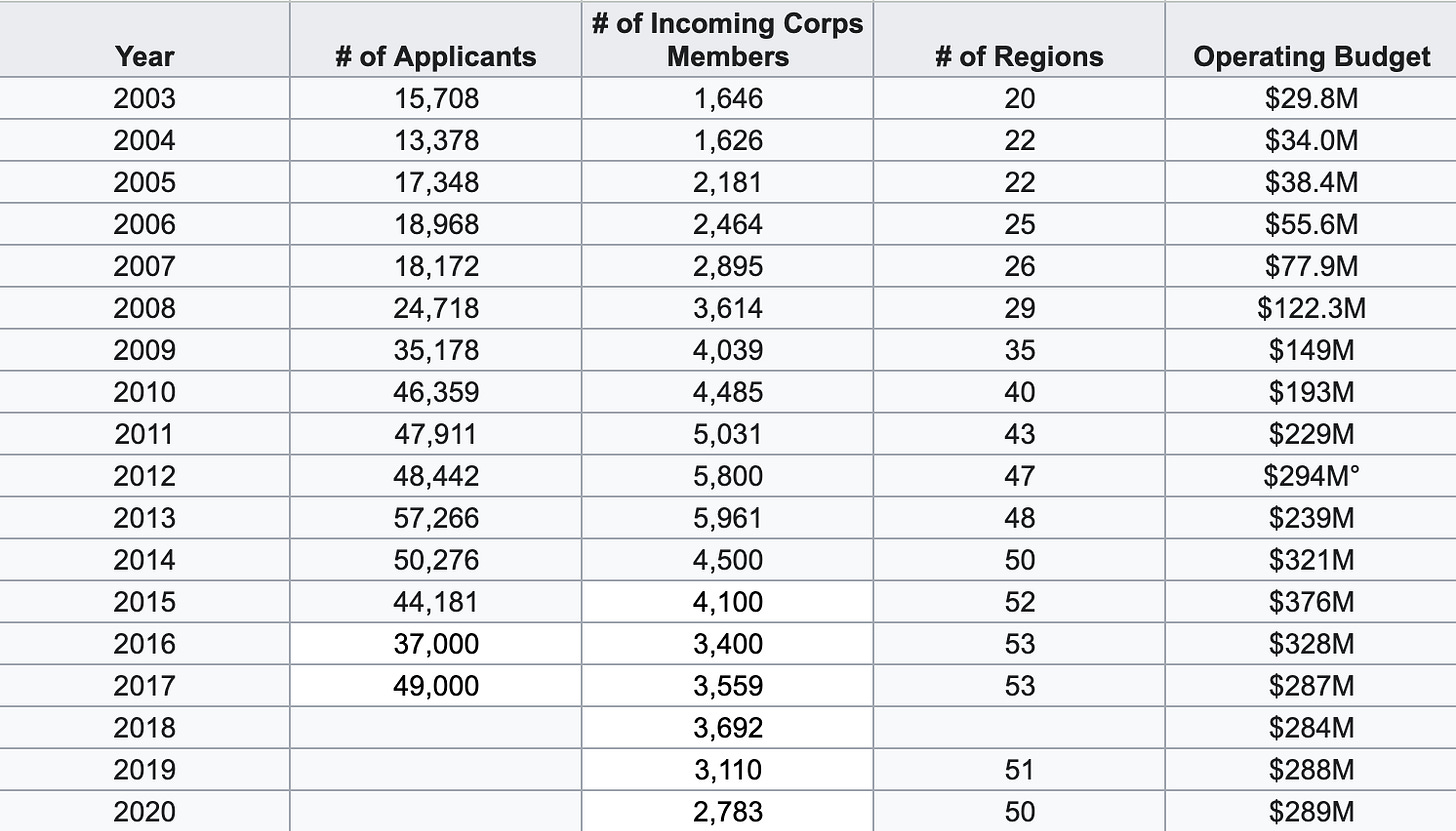Elisa Villanueva Beard first announced she was stepping down as CEO of Teach for America more than a year ago, but the long hunt for a replacement left her in a limbo state. This past week, she finally stepped away from an organization she has been a part of for decades.
TFA announced that Aneesh Sohoni would be their new CEO back in January, and for four months, Elisa Villanueva Beard was transitioning out of the role she’s held for more than twelve years.

She is a phenomenal leader and effective communicator. But she leaves TFA at an inflection point. When she first took the helm of TFA in 2013, their cohort peaked in terms of applicants and corps members: 57,000 college seniors applied (myself included–Michael the year prior), and 5,900 were accepted. That 10.3% acceptance rate is about on-par with Tufts University’s acceptance rate, our alma mater.
The next year, applicants were down 14%, to 50,000. In 2022, there were only 2,000 corps members, although that has improved slightly to 2,300.
This post we’re going to look at the challenges that Aneesh Sohoni will have to grapple with: Fewer people applying and joining the corps, high spend, and damage that Ms. Beard has overseen regarding TFA’s reputation by placing more and more corps members at charter schools.
We write this as TFA alumni, members of TFA’s alumni boards, and people who care deeply about the organization.
Changing of the Guard
In 2013, Harvard and Vanderbilt sent 45 graduates to TFA. Cornell sent 55. Arizona State University sent 42 graduates, ranking 16th place in terms of total corps members. Georgetown sent 40, and Tufts sent 35. Even tiny Yale and Princeton both sent 30.

This past year, ASU took the top spot with 40. Harvard, Tufts, Princeton, and Cornell are nowhere on the list of top contributors. Yale still sent 15 alumni, proportionally higher than in 2013, and Georgetown sent 11.

Part of this shift is to source candidates from more diverse backgrounds, in order to offer a corps more reflective of the populations of students they teach.
But part of this is because fewer college graduates, especially from our most selective universities, are drawn to a profession that requires more work for far less pay than these graduates could make elsewhere. TFA benefitted from the Great Recession: Wall Street’s financials and reputation were still in tatters (Occupy Wall Street in 2011). For many liberal, college-educated millennials, Teach for America offered an opportunity to enter public service.
Those days are long over.
The High Cost of Acquiring Educators
Elisa Villanueva Beard was COO of TFA from 2005 until 2013. Their operating budget under that span of time would increase by more than 620%, while the size of the corps would increase by 270%.
TFA’s operating budget in 2013 was $239M. That’s insane. Especially considering Teach for America doesn’t pay their corps members, outside of relocation and stipends for some. That’s about $22K per active corps member from 2012 and 2013 (since it’s a two year stint). Over $130M of that went to TFA’s own
That’s basically how much the premium is for TFA to source candidates, and about how expensive it is to source candidates now. Obviously, this is not actually reflecting of the range of TFA’s work: Their programming, their professional development. But all of that is ancillary to their core mission of providing a pipeline of talent into a profession whose existing pipeline is drying up faster than the Colorado River.
The next year, in 2014, their operating budget jumped to $376M. In 2020, their operating budget was $289M, 20% higher than in 2013 to support a corps size half as big. In 2023, it was $271M.
These numbers aren’t controlled for inflation, but they do reflect a truth: You have to spend more to attract someone to become a teacher.
TFA has grappled with some hard truths this year, reorganizing and reducing headcount. But the pipeline is shrinking, and total comp for educators isn’t changing. Unless something systemic happens, like say, suddenly paying educators more money, then you need something like Teach for America to help recruit.
29% of TFA’s operating cash flow come from public sources. 71% from private sources.
The School Choice Alliance
There will also be challenges of TFA’s (and Elisa’s) own making: TFA is seen as a solid partner of charter schools, putting them in the cross-hairs for opponents of school choice and charter schools.
The Walton Foundation, one of TFA’s largest donors, pays the organization $4,000 for every teacher placed at a public school–or $6,000 for every teacher placed at a charter school.
This is not bad prima facie. But it is when you consider that Teach for America’s mission is to support ALL learners.
40% of their 2018 corps members were placed at a charter school. 70% of their LA corps that year were placed in charter schools, vs. 15% of students enrolled in a charter.
Nationally, only 7% of students attend a charter school. By placing so many corps members at charters (which are better funded and criticized for siphoning students and funding from traditional public schools), TFA has tarnished its image among many on the left.
What’s Next?
Aneesh Sohoni will need to improve TFA’s corps numbers. With an upcoming recession and attacks on the Department of Education, that might actually happen.
More college students might apply for TFA and wait out a recession in a stable, two-year stint. And more young people might answer the call to serve.
But there will also be less funding as public funding sources dry up. At the minimum, things like Americorps education awards and stipends will be put at risk, which might make TFA less appealing for graduates from lower income backgrounds.
We wish Mr. Sohoni all the best. But we don’t envy the work he has ahead of himself.






